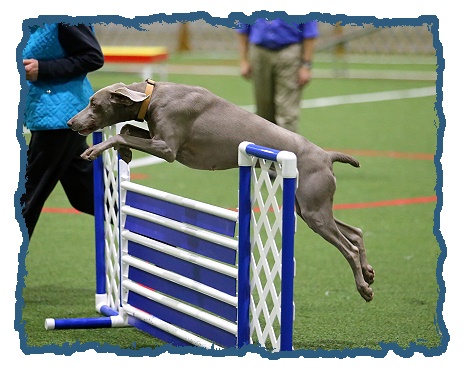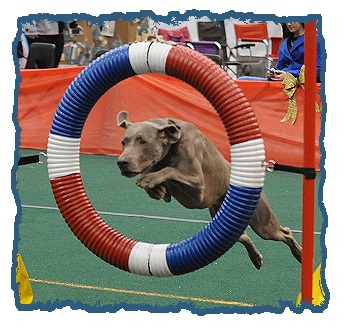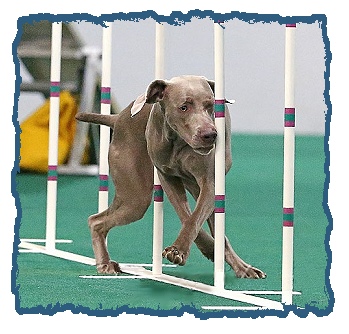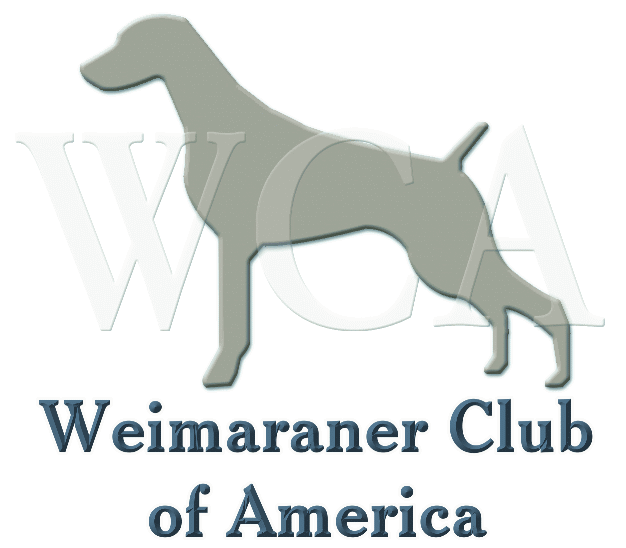
AGILITY
What is Agility?
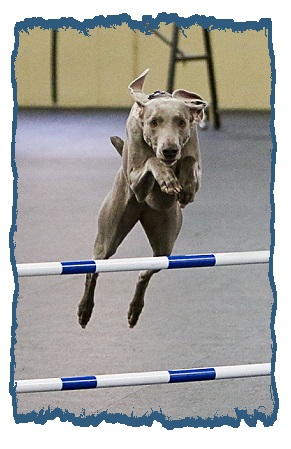 Running a dog in an agility trial is the ultimate game for you and your dog and is one of the most exciting canine sports for spectators. In an agility trial, a dog demonstrates its agile nature and versatility by following cues from the handler through a timed obstacle course of jumps, tunnels, weave poles and other objects. It’s an activity that strengthens the bond between dog and handler and provides fun and exercise for both, which might explain why it’s so enjoyable to watch and has become the fastest–growing dog sport in the United States!
Running a dog in an agility trial is the ultimate game for you and your dog and is one of the most exciting canine sports for spectators. In an agility trial, a dog demonstrates its agile nature and versatility by following cues from the handler through a timed obstacle course of jumps, tunnels, weave poles and other objects. It’s an activity that strengthens the bond between dog and handler and provides fun and exercise for both, which might explain why it’s so enjoyable to watch and has become the fastest–growing dog sport in the United States!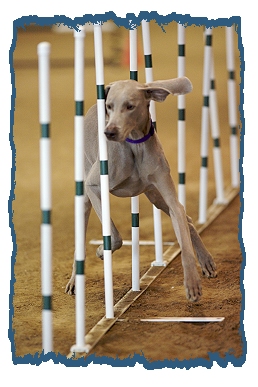
Types of Classes
There are several types of classes offered at an agility trial: Standard, Jumpers with Weaves, Fifteen And Send Time (FAST) and Preferred. The Standard class has contact obstacles, which have yellow “contact zones” at each end. Contact obstacles include A–frame, dog walk and seesaw. The dog must place a least one paw in the contact zone in order not to receive a fault. This encourages safety in training and in running the course. The Standard class also has a variety of jumps; weave poles, pause table, tunnels and a closed tunnel. The Jumpers with Weaves class does not have contact obstacles or a pause table to slow the team’s forward momentum. This is a very fast course requiring instant decisions by the handler and close attention from the dog. The FAST class is an additional test of strategy, skill, accuracy, speed, timing and distance handling, to demonstrate a dog’s athletic ability and willingness to work with its handler in a fast–paced atmosphere over a variety of agility obstacles. As indicated by the title, the Fifteen and Send Time class uses fifteen (15) point–valued obstacles and/or obstacle combinations. The course will include a ‘Send Bonus’ or distance element that will award a bonus of twenty (20) points if completed successfully
Levels of Agility Competition
There are three different levels of competition in agility:
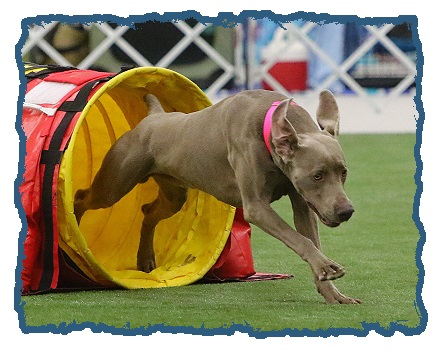 NOVICE – for the dog that is just starting in agility. There are 14 to 16 obstacles on this course. The focus of the Novice class is on performing the obstacles with minimal handling technique.
NOVICE – for the dog that is just starting in agility. There are 14 to 16 obstacles on this course. The focus of the Novice class is on performing the obstacles with minimal handling technique.
OPEN – for the dog that has completed the Novice level. There are 16 to 18 obstacles on this course. The focus of the open class is on more difficult obstacle course performance with more handling skill required.
EXCELLENT – for the dog that has completed the Open level. There are 18 to 20 obstacles on this course. The focus of the Excellent A & B class is to provide the opportunity for dogs and handlers to demonstrate their superior skills in moving quickly and efficiently with close communication and teamwork through challenging agility courses. The Excellent B level is the class where dog/handler teams can earn the title, Master Agility Champion (MACH), in the Regular Classes.
How Agility is Scored
Agility is a time and fault sport where the qualifying requirements are more challenging as the competition class levels get higher. There are two types of faults: time and penalty. Time faults are given for every second a dog goes over the Standard Course Time as set by the length of the course.
Below are examples of Penalty Faults that a judge may assess a handler and dog:
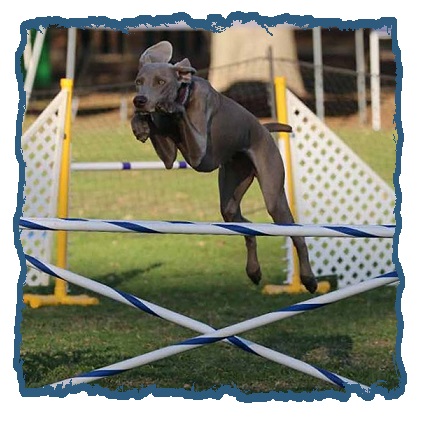
• Taking an obstacle out of sequence
• Missing a contact zone
• Displacing a bar or panel on a jump
• Jumping off the pause table before the judge is through counting
• Running around or refusing the next obstacle
• Exceeding the amount of time set by the judge for running the course
• Touching either the dog or any obstacle by the handler while running the course
• Outside assistance may be penalized
• Handler failure to control the dog may be penalized
Agility Jump Heights
The classes are divided by jump heights in order to make the competition equal between the different sizes of dogs.
REGULAR CLASS
• 8” Class – dogs up to 11” at the shoulder
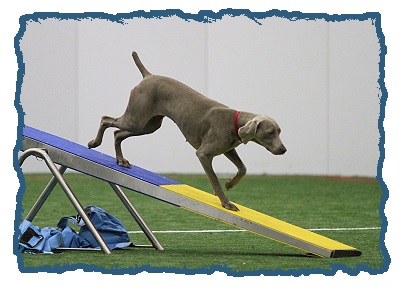 • 12” Class – dogs over 11” and up to 14” at the shoulder
• 12” Class – dogs over 11” and up to 14” at the shoulder
• 16” Class – dogs over 14” and up to 18” at the shoulder
• 20” Class – dogs over 18” and up to 22” at the shoulder
• 24” Class – dogs over 22” at the shoulder
• 26” Class – dogs may be entered at this height at their owner’s discretion.
A dog may jump in a jump height class higher than his/her shoulder measurement, but never lower.
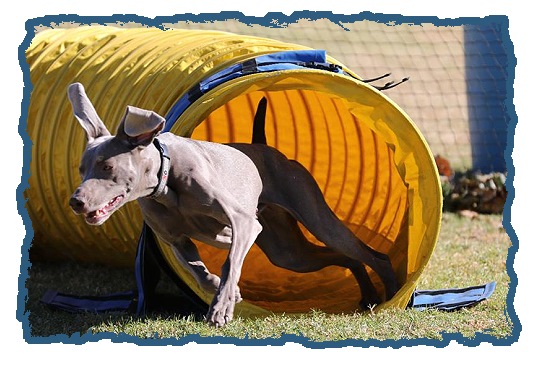 PREFERRED CLASS
PREFERRED CLASS
This class affords an opportunity for a greater variety of dogs, and their handlers, to participate in the sport of agility. Handlers have the option to enter the Preferred classes with modified standards of lower jump heights and more generous course times. They must compete at the required jump height.
Qualifying Performance
A perfect score in any class at any level is 100. A dog must earn 3 qualifying scores under two different judges. The minimum score to qualify is 85 in all classes except in the Excellent B class where the minimum score is 100. The minimum time allowed to run the course and the number of obstacles to complete successfully, increase as the level of difficulty increases.
Reprinted from the AKC website. For additional information please see: http://www.akc.org/pdfs/events/GOCET1.pdf
AGILITY
Training Resources
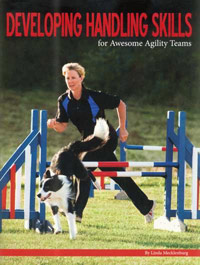 DEVELOPING HANDLING SKILLS FOR AWESOME AGILITY TEAMS
by Linda Mecklenburg
DEVELOPING HANDLING SKILLS FOR AWESOME AGILITY TEAMS
by Linda Mecklenburg
After many years of observation, study, experimentation, and practical application, Linda Mecklenburg has arrived at a simple but comprehensive approach to agility handling that is appropriate for all dogs and handlers, from the beginner to the most accomplished competitor. Developing Handling Skills for Awesome Agility Teams describes how to communicate with your dog and effectively cue him to perform the challenges he will encounter on course.
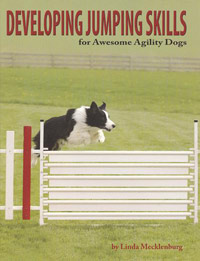 DEVELOPING JUMPING SKILLS FOR AWESOME AGILITY TEAMS
by Linda Mecklenburg
DEVELOPING JUMPING SKILLS FOR AWESOME AGILITY TEAMS
by Linda Mecklenburg
This is a compilation of updated versions of Linda’s jumping articles that originally appeared in Clean Run magazine. She developed this jumping program to help others lay a proper foundation for their dogs’ jumping skills.
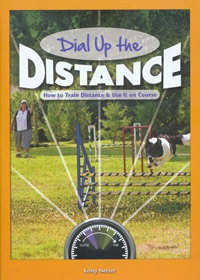 DIAL UP THE DISTANCE DVD by Kristy Netzer
DIAL UP THE DISTANCE DVD by Kristy Netzer
Over 2 hours of step–by–step information to help build those all important distance skills including a 63 page booklet in PDF format.
It’s no secret that today’s agility courses are far tougher and running times are tighter than ever before. Every handler who sets foot in the ring needs solid distance skills in their tool box, but it’s especially crucial when your dog is faster than you. Dial Up the Distance is a comprehensive two–disc program that uses a clear, step–by–step approach to help handlers build these all–important distance skills with their dogs. Kristy Netzer owns and operates two highly respected agility schools (California and Tennessee), and has taught hundreds of students how to incorporate extraordinary distance skills into their handling systems so their dogs can work confidently and accurately away from them.
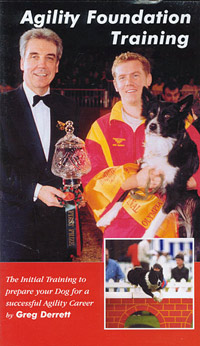 AGILITY FOUNDATION TRAINING DVD by Greg Derrett
AGILITY FOUNDATION TRAINING DVD by Greg Derrett
Covers all the essential basic training techniques to give you and your dog the strong foundation needed to build a successful agility career. Forming a good working relationship; socialising the dog to the competition environment; teaching the "Wait" command; training directional commands; understanding body language; training handling manoeuvres; proofing commands; motivational commands & other beneficial advice; and fitness training.
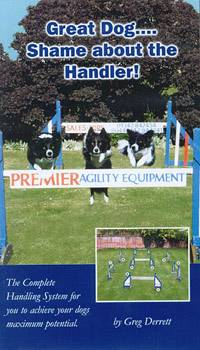 GREAT DOG...SHAME ABOUT THE HANDLER! DVD by Greg Derrett
GREAT DOG...SHAME ABOUT THE HANDLER! DVD by Greg Derrett
Now available in DVD. Greg Derret covers all the handling aspects needed to get the best out of you and your agility dog. Explains in great detail the proven and successful methods and handling system, taking you through more than fifty training exercises. There is an explanation of the complete handling system; clear and precise rules making remembering the system easy; all handling maneuvers are explained and demonstrated; there are exercises to improve all maneuvers; there are training drills to improve the dog’s speed and turning; split screen comparisons of handling maneuvers; and there is a booklet containing all exercises.
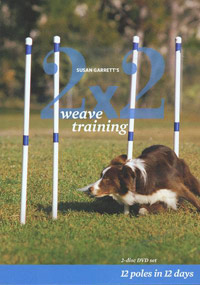 2X2 WEAVE POLE TRAINING DVD by Susan Garrett
2X2 WEAVE POLE TRAINING DVD by Susan Garrett
Never before has there been such a groundbreaking change in the way dogs are trained in the sport of dog agility. Susan Garrett’s revolutionary 2x2 weave training method will take a skill that people previously struggled with for 6–8 months and turn it into one that can be brilliantly trained in just weeks!
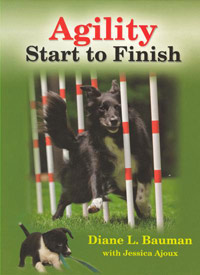 AGILITY START TO FINISH by Diane Bauman
AGILITY START TO FINISH by Diane Bauman
The first book to cover agility from all aspects, all levels! You’ll find something for everyone: from pet owners wanting to have some fun with their dog to serious competitors looking for ways to shave seconds off their score. Starting with puppy training and ending with top level agility competition, Bauman explains each stage of training and each obstacle. Photos and diagrams clearly demonstrate every step.
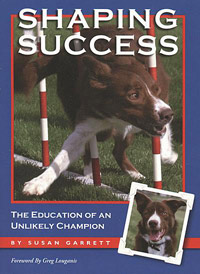 SHAPING SUCCESS – THE EDUCATION OF AN UNLIKELY CHAMPION by Susan Garrett
SHAPING SUCCESS – THE EDUCATION OF AN UNLIKELY CHAMPION by Susan Garrett
Written by one of the world’s best dog trainers, Shaping Success gives an excellent explanation of the theory behind animal learning as Susan Garrett trains a high–energy Border Collie puppy to be an agility champion. Buzzy’s story both entertains and demonstrates how to apply some of the most up–to–date dog training methods in the real world. It’s rare that a trainer shares his or her mistakes as well as successes. Susan presents a great mix of training theory, practical application, and Buzzy stories. Clicker training!
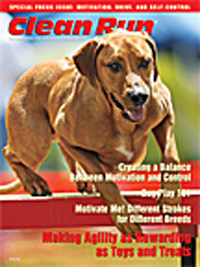 Clean Run Special Focus Issue – Motivation, Drive & Self–Control
Clean Run Productions LLC
Clean Run Special Focus Issue – Motivation, Drive & Self–Control
Clean Run Productions LLC
This special collector’s issue of Clean Runmagazine is all about motivation, drive, and self–control: Susan Garrett explains how to transfer the value of your dog’s favorite reinforcements to his agility performance, Deborah Jones discusses creating the perfect balance of motivation and control, Wendy Pape shows you how to get your dog to play with you without toys or food, Pam Reid discusses the science behind motivation and drive, Rachel Sanders helps you become aware of important motivation dos and don’ts, Leslie Renaud shares her method for training dogs to work happily through "mistakes," Judy Keller talks about how to gain focus and control without losing speed or drive, Tracy Sklenar explains how to train your dog to choose the correct behavior even in stimulating situations, Ann Braue discusses how speed is a skill that can be taught like any other skill, Sherry Kluever looks at start–line techniques for achieving maximum speed and focus, Jo Sermon demonstrates how to motivate dogs by driving him from behind, Angelica Steinker shares fun and useful games for developing attention, motivation, and self–control, Brenna Fender looks at whether a dog’s breed may play a part in what he finds motivating, and much much more!

